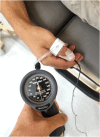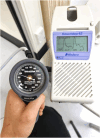The use of a novel toe-thumb pressure index for assessing arterial status in the lower limb. A reliability and validity study
- PMID: 39425819
- PMCID: PMC11490217
- DOI: 10.1002/jfa2.70011
The use of a novel toe-thumb pressure index for assessing arterial status in the lower limb. A reliability and validity study
Abstract
Aims: This study explored the reliability, validity and perceived comfort of a novel thumb pressure measure and calculation of a toe-thumb index to identify their suitability as an adjunct or alternatives to ankle-brachial and toe-brachial indices.
Methods and results: Repeated manual thumb and toe systolic blood pressures were conducted using two raters, over two time points, on 34 healthy participants. Concurrent automated toe, thumb and brachial systolic blood pressures as well as comfort ratings for these measures (using a 10 mm visual analogue scale) were captured once by a research assistant. Automated thumb and brachial measures showed fair correlation (ρ = 0.36, p = 0.03) and a toe-thumb index and toe-brachial index good correlation (ρ = 0.62, p < 0.01). Intraclass correlation coefficients (ICC) identified moderate intra-rater reliability for manual thumb pressures for Rater 1 and 2 (ICC 0.57, 95% CI [0.14, 0.79] and ICC 0.74, 95% CI [0.49, 0.87], respectively), while inter-rater reliability was poor (ICC = 0.16, 95% CI [-0.85, 0.47]). Concurrent validity comparing manual and automated measures for thumb pressure was also poor (ICC -0.05, 95% CI [-1.06, 0.72] and ICC 0.42, 95% CI [-0.16, 0.72] Rater 1 and 2 respectively). Thumb measures were significantly more comfortable than brachial measures (5 mm, p < 0.00).
Conclusion: Thumb systolic pressures are correlated with brachial systolic pressures, with reasonable intra-rater reliability, however, correlation is only fair and measurement error wider than clinically acceptable. Furthermore, manual measures are poorly correlated with automated units. Consequently, caution is required in applying these techniques. As thumb measures were perceived as significantly more comfortable than brachial measures and have an advantage where brachial pressures cannot, or should not, be obtained, further evaluation is warranted.
Keywords: peripheral arterial disease; reliability study; thumb pressure; toe‐brachial index; validity study.
© 2024 The Author(s). Journal of Foot and Ankle Research published by John Wiley & Sons Australia, Ltd on behalf of Australian Podiatry Association and The Royal College of Podiatry.
Conflict of interest statement
All authors declare that they have no competing interests.
Figures









Similar articles
-
Inter-rater reliability of automated devices for measurement of toe systolic blood pressure and the toe brachial index.Blood Press Monit. 2015 Feb;20(1):47-51. doi: 10.1097/MBP.0000000000000083. Blood Press Monit. 2015. PMID: 25171258
-
The reliability of toe systolic pressure and the toe brachial index in patients with diabetes.J Foot Ankle Res. 2010 Dec 22;3:31. doi: 10.1186/1757-1146-3-31. J Foot Ankle Res. 2010. PMID: 21176166 Free PMC article.
-
Intratester and Intertester Reliability of Toe Pressure Measurements in People with and Without Diabetes Performed by Podiatric Physicians.J Am Podiatr Med Assoc. 2015 May;105(3):201-8. doi: 10.7547/0003-0538-105.3.201. J Am Podiatr Med Assoc. 2015. PMID: 26147086
-
Consistency of Toe Systolic Pressures, Brachial Systolic Pressures, and Toe-Brachial Indices in People with and without Diabetes.Curr Diabetes Rev. 2019;15(2):85-92. doi: 10.2174/1573399814666180123113619. Curr Diabetes Rev. 2019. PMID: 29359675 Review.
-
Use of toe systolic blood pressures and toe brachial pressure indices in people receiving dialysis: A scoping review.J Ren Care. 2024 Dec;50(4):513-528. doi: 10.1111/jorc.12514. Epub 2024 Nov 6. J Ren Care. 2024. PMID: 39502075
References
-
- Song, P. , Rudan D., Zhu Y., Fowkes F. J. I., Rahimi K., Fowkes F. G. R., and Rudan I.. 2019. “Global, Regional, and National Prevalence and Risk Factors for Peripheral Artery Disease in 2015: An Updated Systematic Review and Analysis.” Lancet Global Health 7(8): e1020–e1030. 10.1016/s2214-109x(19)30255-4. - DOI - PubMed
-
- Fowkes, F. G. R. , Rudan D., Rudan I., Aboyans V., Denenberg J. O., McDermott M. M., Norman P. E., et al. 2013. “Comparison of Global Estimates of Prevalence and Risk Factors for Peripheral Artery Disease in 2000 and 2010: A Systematic Review and Analysis.” The Lancet 382(9901): 1329–1340. 10.1016/s0140-6736(13)61249-0. - DOI - PubMed
Publication types
MeSH terms
Grants and funding
LinkOut - more resources
Full Text Sources
Research Materials

